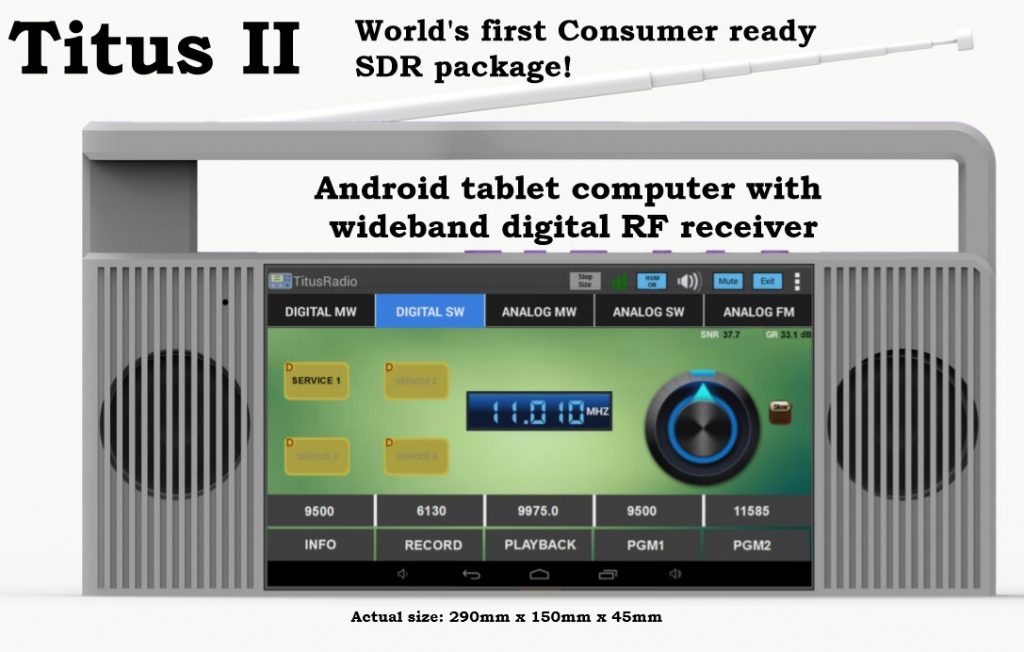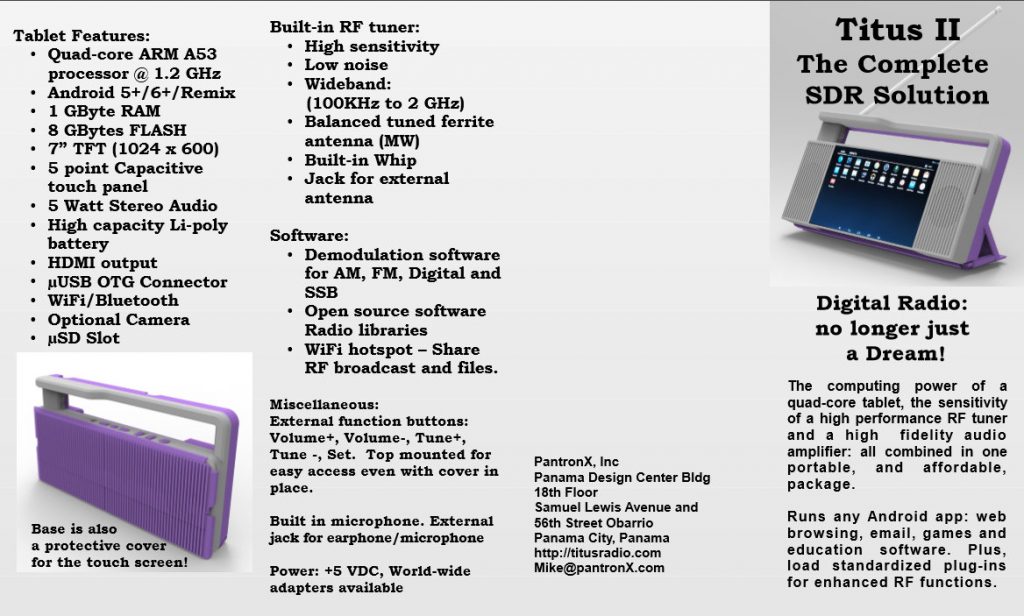Many thanks to SWLing Post contributor, Harald Kuhl (DL1ABJ), who shares more details about the new Titus 2 DRM receiver via the DRM Consortium Chairman, Ruxandra Obreja:
NEW DRM RECEIVER UNVEILED at HFCC MEETING IN MIAMI, FLORIDA THIS WEEK!
The HFCC meeting is being held 22-26 August in Miami and on this occasion there was a live DRM transmission form Radio Vaticana received on the new Titus2 DRM receiver (pls. see attached document with picture and details) http://www.drmna.info/.
Here is also a little testimony of how this prototype to be sold “at under 100 dollars” performed from Ray Robinson, Operations Manager at KVOH (Voice of Hope / Voz de Esperanza):
I’m currently at the HFCC conference in Miami, and reception of the DRM broadcast here this afternoon was very successful. Reception was made outside the hotel on two receivers – a NewStar DR-111 and a brand new pre-production receiver from Pantronix called the Titus 2, with a cluster of attendees gathered round taking photos and videos. The latter receiver is based on an Android tablet in a stereo radio format with one speaker each side of the central horizontal tablet. Reception on both radios was solid throughout, on a day when analog reception on 16m was plagued with a lot of atmospheric noise. We haven’t done detailed calculations, but figure there were probably at least three hops from Italy to Miami, and for a daylight path, the reception quality was nothing short of astounding.



Despite almost 20 years DRM standard is making efforts to make Digital Radio a reality, I think now with this new Receiver Titus II it will be the great trump for it the spreading of DRM, also SDR is becoming quiet spread on the Internet, well come to this new receiver. We SW lovers should not fear this new realise and support the most possible, so International and AM local transmissions will not die.
This one definitely falls under the “shut up and take my money” category at sub-$100 — as long as it works well with some solid first-party software.
I’m happy to see these kinds of products finally coming out with some innovation in the radio space!
I do not believe in “sub-100$”. I have experimented with a no-name tablet in that price range and it had not enough computational power for the tasks we discuss about. Add the relatively small market for such a device and I see it in the 400$ range.
Reality check:
* There have been outdoor smartphones with a low-power 70 cm transceiver. Smartphone-wise they were very unimpressive and cost in the 300-$-range.
* A SDRplay SDR costs 150 $ or so, without any smartphone.
* If you combine an Android device with enough muscle and a reasonable RTL-SDR device you are in the 200-$-range.
I must admit: it’s very hard for me to believe this could be produced for under $100 and there still be profit margin for the manufacturer. Maybe in quantity the BOM comes to $100, but I’ll be surprised if the retail price is less than $100.
I’ll remain cautiously optimistic here. The CPU listed for this device is an ARM-A53 quad-core CPU, which is the exact same $5 system on a chip used in the Raspberry Pi 3. There’s no doubt the Raspberry Pi 3 is perfectly capable of decoding AM, FM, SSB, DRM and CW.
The Android bits of the device look solidly budget-end Android tablet, especially the 1GB RAM, 8GB Flash, and 1024×600 resolution 7″ screen. You can find budget 7″ tablets all day long on AliExpress and similar sites retailing for $42 shipped to the US.
Take the baseline of a budget tablet, and then factor in a likely RTL2832U derived radio, the custom casing, slightly larger speakers, antenna bits, packaging, and I still think this might be doable for sub-$100. It’s an aggressive price point, but I think the success or downfall of this is going to largely depend on how well all the already available components are integrated and engineered together.
Cheap SDR’s tend to need a better front end to avoid RF overload. Hopefully, it should work well with a passive preselector. Very interesting “consumer level” (that means – EASY TO USE) project!!
In more than one sense this unit could be a dream come true. But the manufacturer should look out for a few things:
* A changable battery. We are not used to throw our radios away after three years or so. It will be bad enough to use an outdated Android version.
* Documented API or a well-known RF receiver like a RTL-SDR so third-party programmers can be creative. Think of DAB+, DVB-T, streaming of received signals to the WLAN (and beyond)…
For my taste the unit is to large to be used on the road. At home an internet app would be a strong contender.
DAB+, DVB-T, WiFi, DRM and the new ATSC 3.0 DTV standard for North America all use Coded Frequency Division Multiplex (COFDM) all use technology developed by Australia’s Commonwealth Science Industrial Organisation (CSIRO) who developed this technology to search for black holes in deep space. There was a drawn out patent case in the USA which has forced all the major computer manufacturers using WiFi to pay many millions of dollars for stealing the technology. The money is being used to fund further research.
They made it possible to calculate Fourier’s transforms and their inverse in real time in a chip.
http://www.csiro.au/en/Research/D61/Areas/Wireless-and-networks/Wireless-broadband/WiFi
http://arstechnica.com/tech-policy/2012/04/how-the-aussie-government-invented-wifi-and-sued-its-way-to-430-million/
I never wrote that I expected free apps. But if they invented that technology in the 1990s their patents will expire in the near future.
Don’t worry, it’s not true. “Mangoman” (I won’t reveal his real name) is a well-known “internet kook” on this particular subject, and no matter how many times his claim that “CSIRO invented COFDM” (or, alternately, “CSIRO invented the FFT chip that made COFDM feasible”) is debunked, he keeps repeating it. It’s been going on for years now and, despite all the evidence that’s been provided to him to the contrary (he’s also well-known for demanding other provide hard evidence – which is never good enough for him!), he’s never once been able to provide anything but misunderstood media stories to back up his claim.
The patent he keeps pointing at and alluding to – which was specifically for CSIRO’s technique for compensating for short-delay echoes (e.g. reflections inside a room or building), and came about from work by Dr. John O’Sullivan at the CSIRO’s Radioastronomy division – was included in the 802.11 WiFi specs , but expired nearly 3 years ago.
(A summary of that story can be read at https://www.ipaustralia.gov.au/tools-resources/case-studies/csiro-wlan-patent on the IP Australia website.)
this link to their website works:
https://www.pantronx.com/en-us/index.html